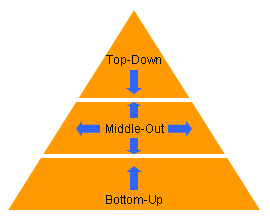
Do all Six Sigma deployment models return the same results – proportionally – to the resources and time invested? The topic of deployment models can be a thorny issue among Six Sigma practitioners. Many claim that the best model is to initiate a Six Sigma program from the “top-down” (ala GE’s Jack Welch, who mandated that every person would be Six Sigma-trained and many would be certified). Others argue that equally enviable results can be obtained fro m “middle-out” or “bottom-up” deployment models.
m “middle-out” or “bottom-up” deployment models.
On June 28, 2005, I had the opportunity, along with Michael Marx, to hear both William Swanson, chairman and CEO of Raytheon, and Timothy Tyson, president and CEO of Valeant Pharmaceuticals, at the ISSSP Leadership Conference in Scottsdale, Arizona, USA. Listening to these articulate business leaders, it became clear that a “top-down” approach to deploying Six Sigma has significant merit. Both set a clear vision and defined strategy for their businesses, and are committed to using Lean Six Sigma to execute. They allocate resources, plan well, complete projects tied to their strategy, expect results and reward accomplishments. They aggressively tackle any roadblocks because they believe Six Sigma will help achieve their ultimate business goals and objectives. This type of deployment is the typical Jack Welch or Larry Bossidy model that led to success at both GE and AlliedSignal, respectively. It takes significant resources, but can often achieve payback within 12 months and return two to three percent of revenue per year (Cyger, Michael [2005]. The Missing Link? Why CEOs Can’t Afford to Ignore Six Sigma. Executive Decision, 40-49).
At the leadership conference I also had the pleasure of speaking with Jens Hansen, director of continuous improvement at Microsoft. Jens described a Microsoft culture of creativity dominated by engineers and programmers where “top-down” initiatives are anything but the norm. Instead, the continuous improvement team at Microsoft focuses on specific and strategic areas for improvement. Microsoft CEO Steve Balmer is unlikely to ever mandate Six Sigma training for the entire organization, but key leaders in strategic roles have experienced the value of Six Sigma in their organization. Terry Burton, consultant and author, would define this type of deployment model as “scaleable” where building blocks of a whole deployment are assembled in such a manner as to transition the organization to a Six Sigma culture at a manageable pace and scope. I call this deployment model “middle-out.” Because it is usually initiated by leaders within one to three organizational layers of the CEO who have credibility, budget authority and the drive for the type of improvement Six Sigma can deliver, this model, too, has the potential to achieve very good results.
The last type of deployment model works from the grassroots or “bottom-up” within an organization – starting with the employees working on the line or in the process itself. These efforts are typically isolated from any political or top-level support. They often take the form of a single group of employees attending Black Belt training, or a small team assigned to Six Sigma efforts within a division or business unit. The results vary greatly depending on how well the project is tied to the business imperatives. Historically, the failure of many grass-roots TQM or continuous improvement efforts to achieve permanence does not bode well for this deployment model.
Perhaps the question of deployment models is not which one is right or wrong, but which one provides the optimal results given the current business conditions, industry environment and corporate culture. For Jack Welch in 1995, a maximum financial benefit in the shortest time period possible was a requirement of doing business. Return on investment was achieved quickly and benefits accelerated every year, but it required a culture that embraced rapid change. William Swanson and Timothy Tyson would most likely agree.
Experts may debate the model issue, but one thing everyone agrees on is that the main purpose of a Six Sigma deployment is to achieve financial results. Which returns us to the opening question: do all Six Sigma deployment models return the same results – proportionally – to the resources and time invested? Six Sigma teaches us to go get data before we make a decision. I think I’ll do the same and work with the iSixSigma editorial team to determine when we might be able to schedule this type of research – although I have a hypothesis on what the results will show. In the meantime, do your own research, understand your unique business culture and environment, and make the choice that fits your needs. Let me know how you make out.